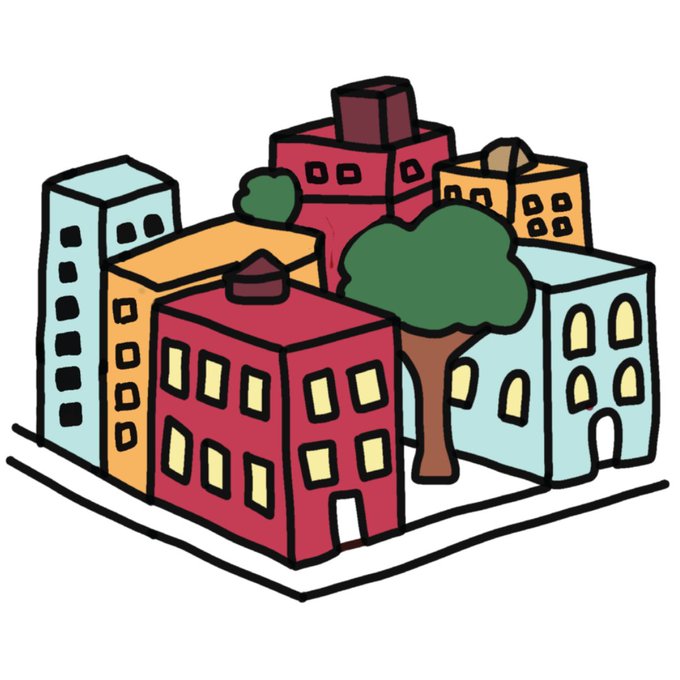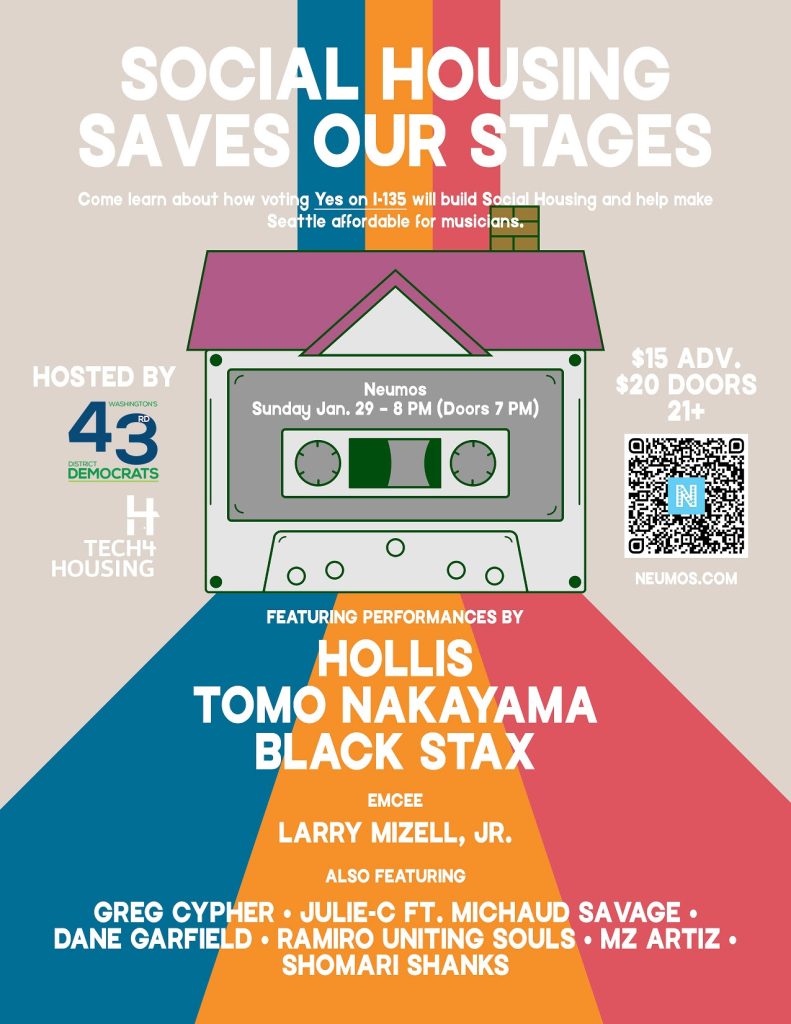
The special election to determine whether Seattle will embrace a new social housing model starts this week. Ballots for Initiative 135 will be mailed Wednesday. Ballot boxes open on Thursday. The deadline to vote is 8pm February 14th, so fill in your oval, sign your envelope, and get it postmarked or into ballot boxes by Valentine’s Day.
In support of I-135, 43rd Democrats and Seattle Tech For Housing are hosting an unique get out the vote rally on Sunday that will also raise money for the campaign. Part educational workshop and part concert, the event will take place at Neumos and feature the musical acts including Hollis, Tomo Nakayama, Black Stax, and KEXP’s Larry Mizell, Jr. as emcee. Tickets are $15 in advance or $20 at the door. Details and tickets here.
Organizers are calling the GOTV concert “Social Housing Saves Our Stages.” Musical performers will also share stories of their housing struggles and what social housing could mean for artists. King County Councilmember Girmay Zahilay is a featured guest, as well.
A numbers of organizations have endorsed I-135 including MLK Labor, Sierra Club, 350 Seattle, Seattle Neighborhood Greenways, Puget Sound Sage, Tenants Union of WA, 34th Legislative District Democrats, 43rd Legislative District Democrats, 46th Legislative District Democrats, and American Institute of Architects—Seattle.
The Urbanist Elections Committee endorsed I-135 in July. Here’s what we said:
Seattle voters may have a unique opportunity this November to support a new model of providing affordable housing, and they should take it. Initiative 135 was crafted by the House Our Neighbors Coalition as a progressive alternative to the Compassion Seattle ballot measure, which sought to codify homeless encampment sweeps before being struck down in court. While Compassion Seattle was built on short-term thinking, I-135 would set up a public developer with the mission of amassing land and creating social housing on it in perpetuity. This is the long-term thinking that Seattle sorely needs.
House Our Neighbors gathered and submitted almost 30,000 ballot signatures in June. Due to invalidations, that total ended up being about 5,000 short of the requirement to win a spot on the ballot, but the campaign gets a 20-day window to gather more signatures to close the gap. On Saturday, July 20th, that 20-day window officially launched.
The coalition should be commended for their hard work, which raised awareness of social housing and the possibility of building housing in a way better attuned to community needs and values. Their big signature-gathering numbers underscore how interested Seattleites are in addressing the city’s housing affordability crisis. We encourage Seattleites to sign the I-135 petition so that voters get to weigh in via a ballot measure.
Cities like Vienna and Singapore have shown the power a well-funded social housing system has to dramatically reduce housing costs for all residents while also producing beautiful, high-quality, environmentally-sustainable homes that build strong communities in highly desirable neighborhoods. For these standout cities, socializing housing production has meant working class families have been able to find stable housing that meet their needs in high-demand urban cores closer to jobs and amenities. In Seattle, it basically takes winning a lottery for this to happen, but I-135 is an important first step toward changing that.
Generally speaking, social housing has a broad definition encompassing multiple forms of below-market housing that provide affordable rents rather than the for-profit model of maximizing returns for landlords and investors. House Our Neighbors has further defined their brand of social housing around four pillars.
- Publicly owned – I-135 would set up a public development authority to hold the land where social housing would be built.
- Permanent affordability – The measure stipulates that housing must remain permanently affordable rather than that guarantee lapsing after a set period like many conventional American models of delivering affordable housing.
- Cross-class communities – By allowing a mix of income levels up to 120% area median income, House Our Neighbors seeks to create cross-class and mixed-income communities in social housing buildings, which sociologists have found to lead to better outcomes.
- Renter leadership – The ballot measure sets up a model of self-governance for tenants in the buildings created and enshrines a strong tenant voice on the board of the public development authority.
Social housing has some key advantages over the city’s traditional method of delivering rent-restricted affordable housing.
Creating cross-class communities doesn’t just provide sociological benefits, it also means a cross-subsidy in which rents from wealthier tenants cover costs incurred providing low rents for low-income tenants. The cross-subsidizing revenue stream helps cover operating costs and allows the possibility of turning a profit which then can be invested in creating yet more social housing. This self sustaining quality is unique and contrasts sharply with the private market where operating profits are simply gobbled up by corporate landlords and paid out to wealthy investors.
Serving a broader band of incomes also means a low-income household can become a higher income household without being kicked out of their housing. Instead their rent continues to adjust to their income level at a manageable 30% level that ensures they aren’t rent-burdened. This housing stability lets tenants put down more roots in their community and not fear a job promotion will mean they’ll lose their housing due to surpassing an income cap.
Land banking is another possibility opened up by a public developer of social housing. Acquiring land early and saving it for social housing will help decrease land costs while ensuring high-demand sites can remain in public ownership and provide permanently affordable housing.
I-135 also has its detractors, and some of their concerns are warranted, if somewhat overblown. It’s true I-135 doesn’t authorize a new revenue source, but state law barred initiative drafters from setting up a public development authority and a new revenue source in a single ballot measure, as House Our Neighbors has pointed out. Moreover, the backers have stressed their intent is to campaign for new progressive revenue after passing the measure, with ballot language also instructing Seattle City Council to aide in setting up a new revenue source.
Additionally, we agree with House Our Neighbors that, contrary to criticisms, a public developer can coexist with traditional nonprofit housing developers and compliment them rather than jeopardize their model and support. The City and State should be doing everything it can to increase funding for both traditional nonprofit housing and publicly-owned social housing. With a regional deficit of tens of thousands of affordable homes, there is certainly is room for both models to grow.
To avoid a souring of public support, the new public development authority should strive be nimble and effective and focus on producing social housing as quickly and efficiently as possible. This will mean enlisting experts and development professionals to navigate the complex process of getting housing designed, approved, and built in Seattle. It won’t be easy, but this new public developer should be given the chance to succeed. The good news is, if it does, public support for funding housing will grow, benefitting both models alike.
Social housing could be just the tool Seattle needs to build its way out of an affordability crisis. Let’s innovate and invest in Seattle as a city for all, not just the mega-rich. Vote yes on I-135 this November.
The Urbanist Elections Committee for the 2022 cycle consists of Lizzy Jessup, Ryan Packer, Hannah Sabio-Howell, Jazmine Smith, Doug Trumm, Rian Watt, and Anita Yandle. Check out the Elections Committee page for more on the members and endorsement process.

Elections Committee
The Urbanist was founded in 2014 to examine and influence urban policies. We believe cities provide unique opportunities for addressing many of the most challenging social, environmental, and economic problems. We serve as a resource for promoting urbanism, increasing political participation, and improving the places we live. The Elections Committee consists of community volunteers and staff members of The Urbanist and is a standing body representing the political values of our organization.

